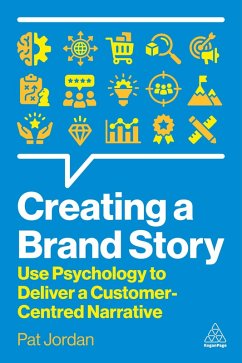Versandkostenfrei innerhalb Deutschlands
28,99 €
inkl. MwSt.
Versandkostenfrei*
Erscheint vorauss. Juli 2025
Melden Sie sich
hier
hier
für den Produktalarm an, um über die Verfügbarkeit des Produkts informiert zu werden.

14 °P sammeln
- Broschiertes Buch
Use psychology to tap into your customers' inner narratives in order to create brand stories that really resonate.
Andere Kunden interessierten sich auch für
![Unscripted Unscripted]() James B StewartUnscripted15,99 €
James B StewartUnscripted15,99 €![Tell Your Story to the World & Sell It for Millions Tell Your Story to the World & Sell It for Millions]() Lisa CerasoliTell Your Story to the World & Sell It for Millions17,99 €
Lisa CerasoliTell Your Story to the World & Sell It for Millions17,99 €![The Economics of Mobile Telecommunications The Economics of Mobile Telecommunications]() Harald GruberThe Economics of Mobile Telecommunications55,99 €
Harald GruberThe Economics of Mobile Telecommunications55,99 €![Public Relations Public Relations]() Young Joon LimPublic Relations111,99 €
Young Joon LimPublic Relations111,99 €![Ethical Space Vol.17 Issue 2 Ethical Space Vol.17 Issue 2]() Ethical Space Vol.17 Issue 240,99 €
Ethical Space Vol.17 Issue 240,99 €![Ethical Space Vol.13 Issue 4 Ethical Space Vol.13 Issue 4]() Ethical Space Vol.13 Issue 439,99 €
Ethical Space Vol.13 Issue 439,99 €![Conquering Communications in Organisations: The Digital Way Conquering Communications in Organisations: The Digital Way]() Marion ScherConquering Communications in Organisations: The Digital Way21,99 €
Marion ScherConquering Communications in Organisations: The Digital Way21,99 €-
-
-
Use psychology to tap into your customers' inner narratives in order to create brand stories that really resonate.
Produktdetails
- Produktdetails
- Verlag: Kogan Page / Kogan Page Ltd
- Seitenzahl: 232
- Erscheinungstermin: 3. Juni 2025
- Englisch
- Abmessung: 234mm x 156mm
- ISBN-13: 9781398618824
- ISBN-10: 1398618829
- Artikelnr.: 70353859
- Herstellerkennzeichnung
- Libri GmbH
- Europaallee 1
- 36244 Bad Hersfeld
- gpsr@libri.de
- Verlag: Kogan Page / Kogan Page Ltd
- Seitenzahl: 232
- Erscheinungstermin: 3. Juni 2025
- Englisch
- Abmessung: 234mm x 156mm
- ISBN-13: 9781398618824
- ISBN-10: 1398618829
- Artikelnr.: 70353859
- Herstellerkennzeichnung
- Libri GmbH
- Europaallee 1
- 36244 Bad Hersfeld
- gpsr@libri.de
Pat Jordan is a global brand consultant, academic and government advisor based in London, UK. As founder of The Worldwide Psychology Company, he advises the private sector and governments on issues of branding, marketing and strategy based on customer insights. As an academic, he is currently Professor of Design Psychology at Middlesex University and Professor of Branding at CEDIM, Mexico. He is a popular speaker and guest lecturer, speaking at conferences such as Forrester Marketing Forum, The Marketing Meet Up and the Market Research Society's Conference.
Section
ONE: Stories and Identities Chapter
01: Why stories are important Chapter
02: How stories can speak to customers' identities Chapter
03: How to find and understand customers' desired identities Section
TWO: Archetypes Chapter
04: Archetypes and how to use them for market segmentation Chapter
05: How brands can use archetypes to tap into customers' desires Section
THREE: Methods and Processes Chapter
06: User requirements Chapter
07: Branding and brand attributes Chapter
08: Creating and using personas Chapter
09: Measuring and evaluating success
ONE: Stories and Identities Chapter
01: Why stories are important Chapter
02: How stories can speak to customers' identities Chapter
03: How to find and understand customers' desired identities Section
TWO: Archetypes Chapter
04: Archetypes and how to use them for market segmentation Chapter
05: How brands can use archetypes to tap into customers' desires Section
THREE: Methods and Processes Chapter
06: User requirements Chapter
07: Branding and brand attributes Chapter
08: Creating and using personas Chapter
09: Measuring and evaluating success
Section
ONE: Stories and Identities Chapter
01: Why stories are important Chapter
02: How stories can speak to customers' identities Chapter
03: How to find and understand customers' desired identities Section
TWO: Archetypes Chapter
04: Archetypes and how to use them for market segmentation Chapter
05: How brands can use archetypes to tap into customers' desires Section
THREE: Methods and Processes Chapter
06: User requirements Chapter
07: Branding and brand attributes Chapter
08: Creating and using personas Chapter
09: Measuring and evaluating success
ONE: Stories and Identities Chapter
01: Why stories are important Chapter
02: How stories can speak to customers' identities Chapter
03: How to find and understand customers' desired identities Section
TWO: Archetypes Chapter
04: Archetypes and how to use them for market segmentation Chapter
05: How brands can use archetypes to tap into customers' desires Section
THREE: Methods and Processes Chapter
06: User requirements Chapter
07: Branding and brand attributes Chapter
08: Creating and using personas Chapter
09: Measuring and evaluating success







